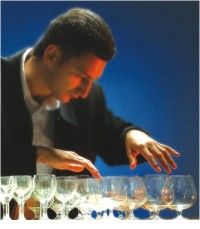Sounds & Rhythm
The wine glass melody
Nazia Ahmed
 ONE of the simplest forms of making melody using the laws of physics was the tuning fork. It deals with resonance. Ever heard a wine glass sing? Well those of you who watched Miss Congeniality must have seen Sandra Bullock with her enticing wine glass performance. The other day a friend of mine while sitting at a restaurant reminded me of this unique music, when he tried to do so with his coke glass. He did not have much luck there. As a matter of fact no matter how simple it might look, it involves quite a bit of interesting techniques. What is happening is that you are demonstrating the principle of stick and slide. As you rub your finger on the rim, your finger first sticks to the glass, and then slides. This stick and slide motion happens only in short lengths and gives off energy to the molecules in the glass and causes them to vibrate. The vibrating glass causes air molecules to vibrate at the same frequency. Many materials such as glass have a natural frequency at which they vibrate, called a resonant frequency. If you put energy into something at its resonant frequency, you will make it vibrate. The sound that you are hearing is from those vibrations that are sending oscillating pulses of energy into wind. ONE of the simplest forms of making melody using the laws of physics was the tuning fork. It deals with resonance. Ever heard a wine glass sing? Well those of you who watched Miss Congeniality must have seen Sandra Bullock with her enticing wine glass performance. The other day a friend of mine while sitting at a restaurant reminded me of this unique music, when he tried to do so with his coke glass. He did not have much luck there. As a matter of fact no matter how simple it might look, it involves quite a bit of interesting techniques. What is happening is that you are demonstrating the principle of stick and slide. As you rub your finger on the rim, your finger first sticks to the glass, and then slides. This stick and slide motion happens only in short lengths and gives off energy to the molecules in the glass and causes them to vibrate. The vibrating glass causes air molecules to vibrate at the same frequency. Many materials such as glass have a natural frequency at which they vibrate, called a resonant frequency. If you put energy into something at its resonant frequency, you will make it vibrate. The sound that you are hearing is from those vibrations that are sending oscillating pulses of energy into wind.
By adding different amounts of water, you can change the pitch of the singing wine glass. As that vibrating wave moves around the glass, it drags those water molecules with it, making a wave of water that you can see near the edge of the glass.
Every material (such as glass, steel, concrete) has a natural frequency at which it vibrates, called a resonant frequency. If you put energy into the substance at its resonant frequency, you will force it to vibrate or.
So, how does the water change the pitch of the singing wine glass? As the resonant wave moves around the glass, it drags the water molecules with it, creating a wave of water that you can see near the edge of the glass. The dragging water molecules effectively increase the mass (both the water and the glass molecules) and reduce the energy of the wave traveling through the glass. When the energy is reduced, so is the frequency of the wave in the glass, which is reflected in the pitch of the sound wave that you hear. If you impart enough energy to the glass at its resonant frequency, you can cause the glass to shatter. However, this takes more energy than you can provide by rubbing the rim. Some singers can sing a note equal to the resonant frequency of a wine glass and cause it to shatter!
Sources: Internet
|
